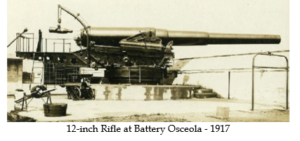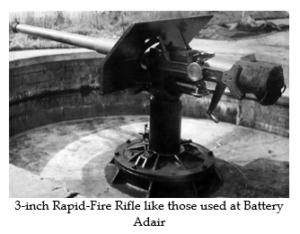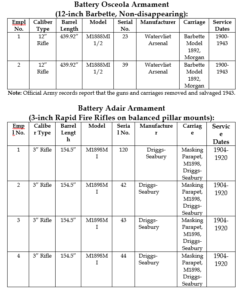Endicott Period Batteries at Fort Taylor
Beginning in 1885, a joint army, navy and civilian board, headed by Secretary of War William C. Endicott, studied the needs of America’s coastal defenses. This Board would become known as the Endicott Board. The findings of the board painted a grim picture of existing defenses in its 1886 report. They recommended a massive $127 million construction program of state-of-the-art breech loading cannons, mortars, floating batteries, and submarine mines for some 29 locations on the US coastline.
These changes were necessary since all efforts at harbor defense construction had ceased in 1876. In the late 1880’s, heavy ordnance technology advanced rapidly, including the developme nt of superior breech loading and longer-ranged cannon, making the brick and mortar fort-based U.S. harbor defenses obsolete. In 1883, the navy began their own ship construction program with an emphasis on offensive rather than defensive warships. These factors combined to create a need for improved coastal defense systems.
nt of superior breech loading and longer-ranged cannon, making the brick and mortar fort-based U.S. harbor defenses obsolete. In 1883, the navy began their own ship construction program with an emphasis on offensive rather than defensive warships. These factors combined to create a need for improved coastal defense systems.
The Endicott Board’s recommendations would lead to a large scale modernization program of harbor and coastal defenses in the United States, especially the construction of modern reinforced concrete fortifications and the installation of large caliber breech loading artillery and mortar batteries.
Battery Osceola – served from 1900 to 1943. Armed with two 12″ M1888MI1/2 guns mounted on M1892 Barbette carriages. Battery was used periodically through 1943 when it was declared obsolete. It was deactivated and its guns and mounts salvaged for scrap metal. The Battery with its magazines and shell hoists was abandoned in place and remains a key part of Fort Taylor. In Key West, the Army laid out a plan for ten new batteries to be built primarily on the southwest shore of the island with two to be constructed within Fort Taylor. These new batteries mounted a total of 30 guns ranging in size from 3 inches to 12 inches. The following section illustrates the scope and armaments assigned to these batteries:

Note: When Battery Osceola was completed in 1900, the name “Fort Taylor” was linked to the island reservation that would contain the other Endicott Batteries described above. When Howard England was given the task of evaluating the historical value of the old brick fort called Fort Taylor, he had to do some research as to where such a fort might be found. All of his life, he had known Fort Taylor as simply Battery Osceola. On the Base Map that he drew for the Navy in 1965, the name given to the “Fort” was Battery Osceola. Fort Taylor at that time referred to the area of the Navy’s Officers Club and beach recreation area!
Battery Adair – served from 1904 to 1920. Armed with two 3″ rapid fire M1898MI guns mounted on M1898 Masking Parapet mounts like those on Battery Dilworth. Battery was used periodically until 1920 when it was declared obsolete. It was deactivated in 1920; the guns were transferred back to Watervliet Arsenal on 17 Sep 1920 and the carriages were scrapped 20 May 1920. The structure was abandoned in place and remains as a key component of the history of Fort Taylor.

Note: – When the moat was dug around the Fort in 1983, the four Masking Parapet mounts were dredged up and have been preserved. That brought into question exactly what happened to the guns of Battery Adair. The Army orders had dictated that the mounts were to be removed and returned to the Watervliet Arsenal. Divers in 1992, detected four long, slender metal objects below the bottom level that might be the gun tubes. But until such time as further exploration is allowed, the mystery of where Battery Adair’s guns really went is still there!
[Author’s Note] While not present at Fort Taylor when Howard England was excavating at the Fort, research has confirmed that the following guns were emplaced in Batteries Osceola and Adair during the renovations which began in 1898:

Other Endicott Batteries in Key West
Battery Seminole – served from 1904 to 1942. Armed with 8 12″ M1890MI mortars mounted on M1896MI mortar carriages. Mortars were mounted in two pits with four tubes in each one. Used periodically through beginning of World War II and then declared obsolete. Battery was deactivated in 1942; mortars were removed and sold in December 1944. Battery was abandoned in place in 1944. The rear of the Battery revealing the mortar pits may still be seen on Naval Annex property from the Fort Street parking lot.
Battery De Leon – served from 1904 to 1942. Armed with four 10” M1888MII guns mounted on M1896 disappearing carriages. Used periodically through beginning of World War II and then declared obsolete. Battery was deactivated in 1942; guns were removed in 1943. Battery was demolished in 1943.
Battery Covington – served from 1904 to 1917. Armed with two 8″ M1888MII guns mounted on M1894 disappearing carriages. Used only through beginning of World War I and then declared obsolete. Battery was deactivated in 1917; guns were removed in October 1917. Battery was demolished in 1962.
Battery De Kalb – served from 1906 to 1917. Armed with two 6″ M1900 guns mounted on M1900 Barbette carriages. Battery was used through beginning of U.S. participation in World War I and then declared obsolete. Battery was deactivated in 1917; guns were removed in 1917. Battery was demolished in 1950’s.
Battery Gardiner – served from 1900 to 1913. Armed with two 4.72″ Armstrong guns mounted on Armstrong carriages. Battery was used only sparingly until it was declared obsolete. It was deactivated in 1913. The guns and carriages were dismounted and shipped to Hawaiian Islands, Jul 1913, and the battery abandoned. Battery was demolished in 1962.
Battery Ford – served from 1906 to 1945. Armed with two 3″ rapid-fire M1903 guns mounted on M1903 pedestal mounts. Battery was used periodically through the latter years of World War II and then declared obsolete. Battery was deactivated in 1945; the guns and carriages were processed for salvage 16 May 1945. Battery was demolished in 1964.
Battery Inman – served from 1906 to 1945. Armed with two 3″ rapid-fire M1903 guns mounted on M1903 pedestal mounts. Battery was used periodically through latter years of World War II and was declared obsolete. It was deactivated in 1945; the guns and carriages were processed for salvage 16 May 1945. The gun pits for Battery Inman remain in place even today at the Key West Garden Club’s facility at West Martello Tower.
Battery Dilworth – served from 1901 to 1920. Armed with two 3″ rapid fire M1898MI guns mounted on M1898 Masking Parapet mounts. Battery was used periodically until 1920 when it was declared obsolete. It was deactivated in 1920; the guns were transferred back to Watervliet Arsenal on 17 Sep 1920 and the carriages were scrapped 20 May 1920. Battery structure was demolished in the 1970’s.
Only Batteries Osceola, Adair, and Seminole remain of all the Endicott Period additions to Fort Taylor.
Note: Two streets on the Navy’s Truman Annex still bear names from the Endicott Period: Covington Avenue and De Kalb Avenue. You can check this out on Google© Earth.